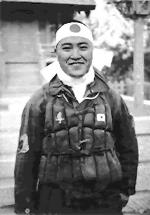The Kamikaze (神風, literally: "Spirit wind"; common translation: "Divine wind") [kamikaꜜze] , official name: Tokubetsu Kōgekitai (特別攻撃隊, literally: "Special attack unit"), abbreviated as Tokkō Tai (特攻隊) and used as a verb as Tokkō (特攻) ("special attack") were suicide attacks by military aviators from the Empire of Japan against Allied naval vessels in the closing stages of the Pacific campaign of World War II, designed to destroy warships more effectively than was possible with conventional attacks. Numbers quoted vary, but at least 47 Allied vessels, from PT boats to escort carriers, were sunk by kamikaze attacks, and about 300 damaged.[citation needed] During World War II, about 3,860 kamikaze pilots were killed, and about 18.6% of kamikaze attacks managed to hit a ship.Kamikaze aircraft were essentially pilot-guided explosive missiles, purpose-built or converted from conventional aircraft. Pilots would attempt to crash their aircraft into enemy ships in what was called a "Body Attack" (体当たり; 体当り, taiatari) in planes laden with some combination of explosives, bombs, torpedoes and full fuel tanks; accuracy was much better than a conventional attack, and the payload larger. A kamikaze could sustain damage which would disable a conventional attacker and still achieve its objective. The goal of crippling or destroying large numbers of Allied ships, particularly aircraft carriers, was considered to be a just reason for sacrificing pilots and aircraft.These attacks, which began in October 1944, followed several critical military defeats for the Japanese. They had long lost aerial dominance due to outdated aircraft and the loss of experienced pilots. On a macroeconomic scale, Japan experienced a decreasing capacity to wage war, and a rapidly declining industrial capacity relative to the United States. The Japanese government expressed its reluctance to surrender. In combination, these factors led to the use of kamikaze tactics as Allied forces advanced towards the Japanese home islands.While the term "kamikaze" usually refers to the aerial strikes, it has also been applied to various other suicide attacks. The Japanese military also used or made plans for non-aerial Japanese Special Attack Units, including those involving submarines, human torpedoes, speedboats and divers. Nazi Germany formed its own group of suicide aircraft pilots called the Leonidas Squadron, but German commanders were more reluctant to use them.The tradition of death instead of defeat, capture, and perceived shame was deeply entrenched in Japanese military culture. It was one of the primary traditions in the samurai life and the Bushido code: loyalty and honour until death.




Comment
0